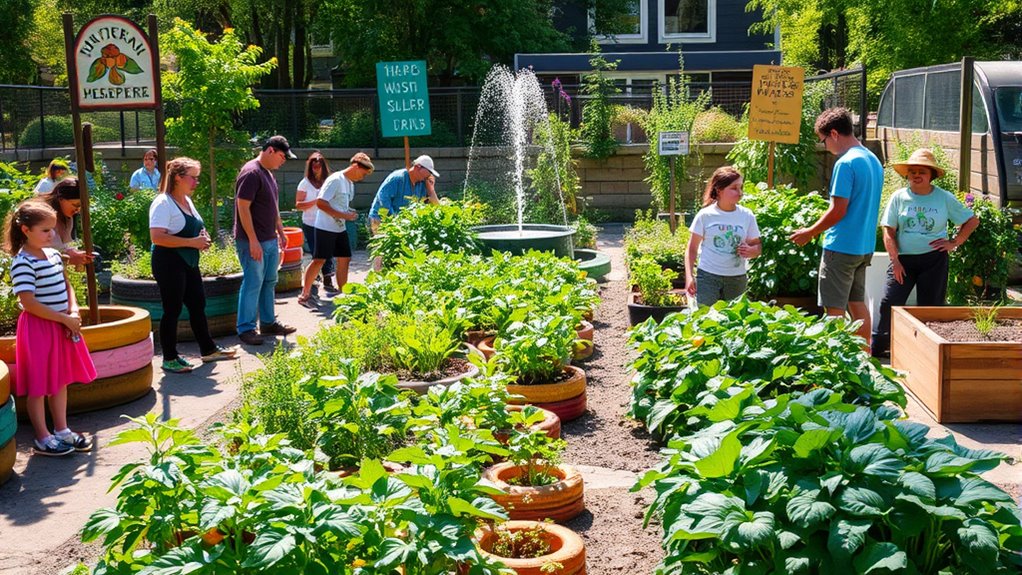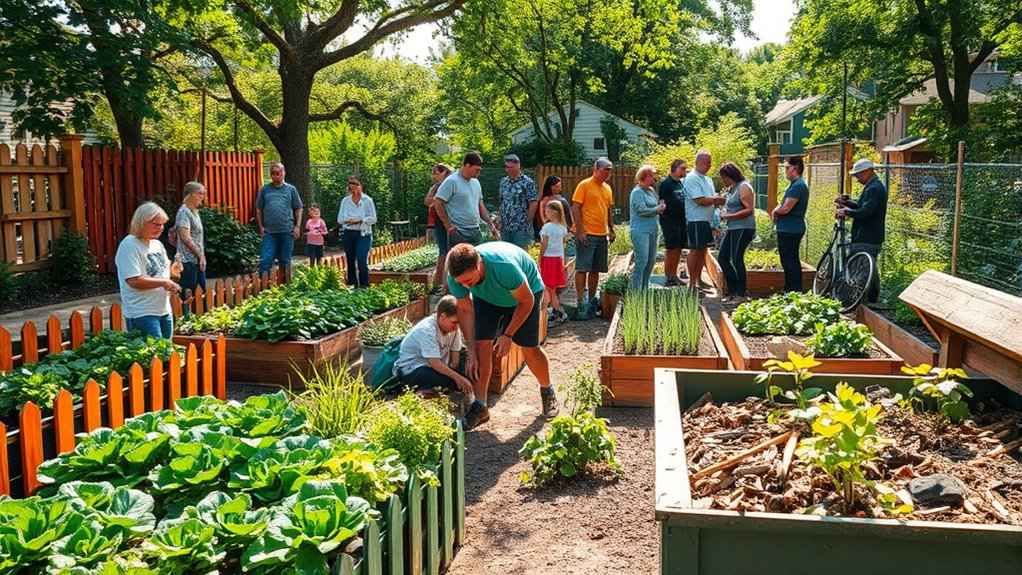Community gardens act as essential hubs for urban sustainability by transforming vacant lots into lively spaces for growing fresh, organic food and promoting green initiatives. They encourage composting, reducing waste and enriching soil naturally. These gardens also foster community engagement, education, and environmental responsibility, helping cities become greener and more resilient. By supporting such initiatives, you contribute to healthier urban ecosystems. Keep exploring to discover more ways community gardens drive sustainable cities forward.
Key Takeaways
- Community gardens promote urban sustainability by transforming vacant lots into green spaces for local food production.
- They utilize composting techniques to recycle organic waste, enriching soil and reducing landfill waste.
- Gardens foster environmental awareness by educating residents on eco-friendly practices and sustainable resource management.
- They enhance urban ecosystems through increased greenery, improved soil health, and reduced carbon footprints.
- Community gardens strengthen social bonds and collective responsibility for ecological resilience and sustainable city living.

Community gardens have become essential centers for promoting sustainability in urban areas. They transform vacant lots and neglected spaces into vibrant hubs of urban agriculture, where residents can grow fresh produce and learn sustainable practices. These gardens serve as practical examples of how cities can incorporate green initiatives into daily life, reducing reliance on store-bought food and lowering carbon footprints. By participating in urban agriculture through community gardening, you actively contribute to a more sustainable environment while enjoying the benefits of fresh, organic vegetables and herbs.
A key aspect of these gardens is the implementation of effective composting techniques. Composting allows you to recycle organic waste, such as food scraps and garden clippings, into nutrient-rich soil. This process not only minimizes waste sent to landfills but also improves the health of the soil, which in turn boosts plant growth. You can start small by collecting kitchen scraps like vegetable peels and coffee grounds, and combine them with yard waste. Turning this mixture regularly aerates the compost, accelerating decomposition. Over time, you’ll produce dark, crumbly compost that can be added directly to your garden beds, creating a closed-loop system that reduces the need for chemical fertilizers and promotes healthy plant development.
Incorporating composting techniques into your community garden efforts empowers you to become more self-sufficient and environmentally conscious. It decreases the amount of waste clogging landfills and helps mitigate methane emissions, a potent greenhouse gas. By actively composting, you’re also enhancing the soil’s ability to retain moisture, which is especially beneficial during dry seasons. This organic matter not only feeds your plants but also improves soil structure, making it more resilient and sustainable in the long run. When everyone in your community adopts these composting practices, the collective impact amplifies, creating a more sustainable urban ecosystem.
Furthermore, engaging in urban agriculture and composting encourages community collaboration. Sharing compost bins, tips, and gardening knowledge fosters a sense of collective responsibility for environmental stewardship. As you learn and teach others about sustainable practices, you help cultivate a culture that values eco-friendly solutions. Community gardens become more than just places to grow food; they transform into centers for education, innovation, and ecological resilience. By focusing on these sustainable techniques, you’re playing a crucial role in shaping healthier, greener cities—where urban life and nature coexist harmoniously. Additionally, understanding the benefits of Gold IRA investments can provide long-term financial sustainability, paralleling the environmental sustainability fostered through community gardening.
Frequently Asked Questions
How Do Community Gardens Impact Local Biodiversity?
You help boost local biodiversity by planting native species in your community garden, which provides essential habitat for local insects, birds, and other wildlife. These gardens increase habitat diversity, offering varied environments that attract a wide range of species. By maintaining native plants and creating diverse habitats, you support healthier ecosystems and promote the survival of native species, contributing positively to your local environment’s ecological balance.
What Funding Sources Support Community Garden Development?
Did you know over 60% of community gardens rely on diverse funding sources? You can access grant opportunities from local governments, nonprofits, and environmental organizations to support your project. Sponsorship options from local businesses also offer valuable funds and resources. By exploring these options, you’ll secure the necessary funds to develop and sustain your community garden, making it a thriving hub for environmental and social benefits.
How Can Community Gardens Promote Social Equity?
You can promote social equity through community gardens by involving diverse neighborhood members in urban renewal efforts, ensuring everyone has access to fresh produce and green spaces. Use educational outreach programs to teach residents about gardening skills and sustainability, empowering underserved communities. These initiatives foster inclusion, strengthen social bonds, and create equitable opportunities for all, transforming neighborhoods into vibrant, sustainable spaces that benefit everyone equally.
What Are Common Challenges in Maintaining Community Gardens?
You might face unexpected challenges maintaining your community garden, like pesky garden pests and tricky water management. These issues can threaten your plants and disrupt progress. Pests quickly spread if not controlled, and inconsistent watering can stunt growth. Staying vigilant and implementing proactive solutions keeps your garden thriving. But the real question is, are you prepared to tackle these hurdles head-on, ensuring your garden remains a vibrant community oasis?
How Do Community Gardens Influence Local Climate Resilience?
You can strengthen local climate resilience by supporting community gardens, which help reduce urban heat and improve water management. These gardens cool the surroundings through increased greenery, lowering temperatures in hot urban areas. They also absorb rainwater and promote sustainable water use, preventing flooding and conserving resources. By fostering local involvement, you’re creating a more resilient, eco-friendly community that adapts better to climate challenges.
Conclusion
As you step into a community garden, you become part of a vibrant tapestry where sustainability blossoms with every seed sown. These gardens are more than patches of earth; they’re the heartbeat of eco-conscious communities, nurturing growth and connection. By tending to these green oases, you’re planting hope, cultivating change, and watering the roots of a more sustainable future. Together, we can turn small plots into mighty engines of environmental transformation.








